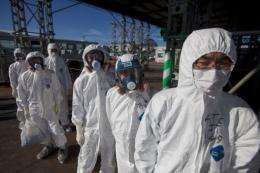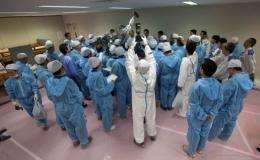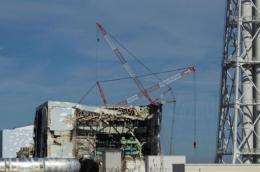Japan opens Fukushima reactors to outside eyes

Japan took a group of journalists inside its crippled nuclear plant for the first time on Saturday, stepping up efforts to prove to the world it is on top of the disaster.
More than 30 members of the press, wearing protective masks and anti-radiation suits and confined to buses, saw the devastated buildings housing the reactors at Fukushima Daiichi, the scene of the planet's worst atomic disaster since Chernobyl a quarter century earlier.
One journalist reported how four reactor buildings were in varying states of destruction, with the one around reactor number 3 largely collapsed.

He said the bases of the buildings, which stood on ground just 10 metres (30 feet) above sea level, were filled with crumpled trucks, twisted metal fences and large buckled water tanks. Other buildings in the compound also showed signs of the destruction wrought by the 14-metre-high tsunami.
Crows and dragonflies could be seen around the reactors, in an area the reporter's dosimeter recorded radiation at 50 microsieverts per hour.
Nearer to the reactors the reading rose to 300 microsieverts (0.3 millisieverts), the highest of the trip.
The Japanese government-set threshold for evacuation from a normal area is accumulated radiation of 20 millisieverts per year.
Despite a series of setbacks, including the revelation last week that spontaneous fission had been detected inside a reactor that was supposed to be all but extinct, the government and plant operator TEPCO (Tokyo Electric Power Company) say they remain on track for a cold shutdown by the end of the year.
The tour, in which just four representatives from foreign media were allowed to participate, is part of efforts by TEPCO to show they are close to solving the problem.
TEPCO told journalists on Saturday there were around 1,600 people at Fukushima Daiichi, half of the weekday number, working to tame the reactors, whose cooling systems were knocked out by the March 11 quake and tsunami, which killed around 20,000 people.
The atomic crisis, which has seen radiation leaking into the air, sea and food chain, has not in itself claimed any lives but has badly dented the reputation of nuclear power, a key source of energy in resource-poor Japan.
Thousands of people remain evacuated from a large area around the plant, 220 kilometres (140 miles) northeast of Tokyo, with no indication when the many who left homes and farms in the shadow of the reactors will be able to return.
With search operations hampered by nuclear contamination, police figures this month showed more than 200 people were still listed as missing in the area.
Goshi Hosono, the minister in charge of nuclear accident settlement and prevention, told workers in the plant's seismic isolation building -- the onsite logistical headquarters for the clean-up -- that the situation at the plant was steadily improving.
"Every time I come back, I feel conditions have improved. This is due to your hard work," he told the workers.

He reiterated the government's intention of achieving cold shutdown of the reactors by year-end, but cautioned that 30 years' work remained to be done to dismantle the machinery.
In what state broadcaster NHK called his first interview since the disaster, Fukushima Daiichi plant chief Masao Yoshida said March had been a very frightening time.
"In the first week immediately after the accident I thought a few times 'I'm going to die'," he said.
And referring to when a hydrogen explosion tore apart the buildings around rectors 1 and 3, he said: "I thought it was all over."
Yoshida also said there were still spots of dangerously high radiation in the compound but he wanted residents to feel relieved as reactors are now stabilised, according to NHK.
On Friday, journalists were taken to J-Village, Japan's national football training centre which has been converted for use as a base for workers battling to contain the disaster.
A mountain of contaminated clothing, masks and other protective gear used by plant workers stood at the training centre, reporters said, left there in plastic bags as no decision has yet been made on how to dispose of them.
Last week the government agreed to give TEPCO 900 billion yen ($11.5 billion) to help it pay compensation to those affected by the disaster.
The company is also expecting to receive an additional 120 billion yen under a Japanese law related to nuclear accident compensation, meaning that in total it will receive over one trillion yen.
(c) 2011 AFP





















